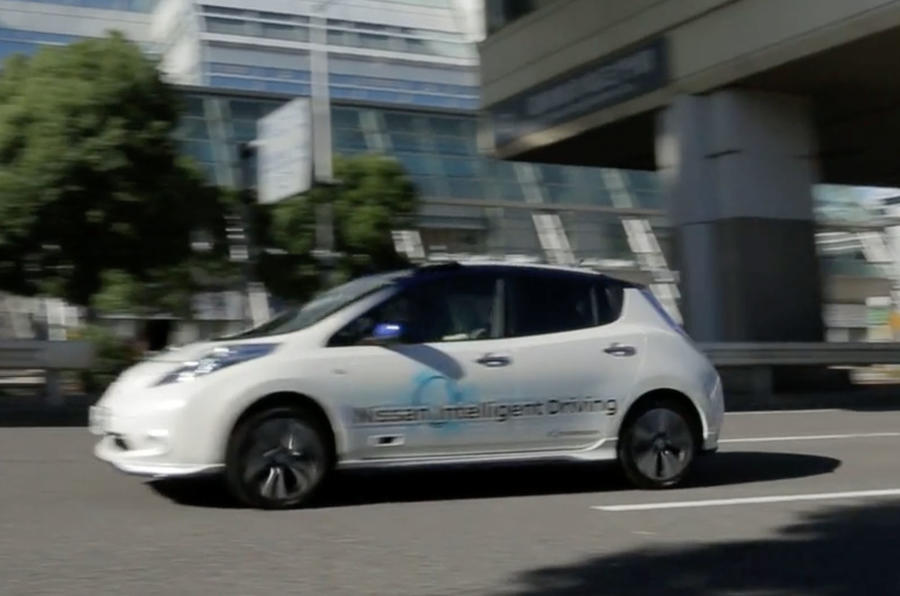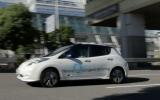It may look like a perfectly ordinary Nissan Leaf, but it's far from that. This one can take you on any journey you plot on its navigation screen - through suburbs and traffic, over bridges and on motorways at speeds of up to 80mph - without requiring anyone to touch its wheel.
Engineer Tetsuya Iijima and I did it earlier today, as a matter of fact, starting just down the street from where they're about to open the Tokyo motor show. Iijima, leader of the Nissan Intelligent Driving project, was the one who occupied the driver's seat, but on a 20-minute drive neither of us needed to touch the wheel. Or the brakes or accelerator.
The company will offer Intelligent Driving in a reduced form in Japan from next year and in Europe in 2017. In essence, you'll get help in traffic jams with distance control and automatic braking, and with lane keeping and speed control on motorways. But true hands-off operation will have to wait a little longer, even though it's very much technically feasible, as Nissan was keen to demonstrate. It is part of a move towards a 'Zero Emissions, Zero Fatalities' vision the company holds.
A walk around our Leaf soon showed some key differences from a standard car. Its open boot revealed a luggage space stuffed with electronics, which we were reassuringly told could eventually be housed in a small black box. On the roof were two camera-scanners pointing to each side of the car, with three more pointing forward through the upper windscreen,and one rearward - all of it part of an eight-way, 360deg camera system.
In addition, on each front door at about shin height were a pair of laser scanners, especially useful for close encounters in traffic. These allowed the car to be positioned within 2-3mm of accuracy in a suburban lane, said Iijima, whereas radar offered 10cm at best, not really enough for low-speed, close-quarters driving.
The car's interior was all Leaf, apart from a head-up display to warn the operator of approaching manoeuvres and a display ahead of the driver showing how far ahead the system was planning, as it were. When stationary, you'd have a view of the car in front; when cruising, you'd have an overhead view of a little car on a big road.
To go, Iijima simply drove the car manually into the traffic to a point known to the navigation system, switched it on with a twist control on the console, and let it do its thing. We drove steadily on a 20-minute route, obeying every speed limit to the letter, neatly making lane changes when needed and keeping a sensible but not too conservative distance from cars ahead. It was like being driven by a safe but slightly too fastidious driver. Keener drivers would have 'taken a line' through the corners and reacted differently to the erratic cornering of those in front, but it was a superb demonstration. Only once did the system need any form of correction by Iijima, when it failed to see a speed limit sign that would have allowed it to speed up. But there can be no doubt that systems like this are coming fast, or that they'll be desirable, at least a major part of the time.






















Join the debate
Add your comment
@ Adrian987
Speed limits will be automatically and unflinchingly maintained, any ability to 'express' yourself through your 'driving style' will be surrendered to the control of the machine and the state who will monitor your every move.
At this stage Premium and Sporting car manufacturers will find it harder to appeal to individuals hearts since this will be a purely rational purchase (probably a lease actually, as no one will derive pleasure of ownership),and therefore relieve them of premium prices.
Thank god I will not be around to witness this monotony!
I too considered 'what would happen when the detector lasers are covered in Mud or Snow'...You are right - 'Limp home mode'
Vision of a road test
What's it like?
The car comes standard with autonomous driving capability and by and large can be left to drive itself, relegating the driver to being no more than an alert observer in a comfortable chair. The system has to be deactivated (by laboriously delving through menus) to allow driver completion of certain manoeuvres, such as permitted on-pavement parking. On the limit handling could not be tested, as this is no longer legal on any (new) car in highway use, per EU test regulations. One problem we did find was that in snow conditions, there was no automatic snow clearing facility for the onboard cameras and other detectors, and this sent the vehicle into "limp-home" mode.
Should I buy one?
As driving enthusiasts, we find any car with modern technology difficult to recommend over an "old school" rear drive saloon with a decent petrol engine and manual shift.